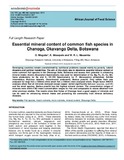Essential mineral content of common fish species in Chanoga, Okavango Delta, Botswana

View/
Date
2015-11-30Author
Mogobe, Oarabile
Mosepele, Ketlhatlogile
Masamba, Wellington R.L.
Publisher
Academic Jornals, http://www.academicjournals.orgRights
This article is published under the terms of the Creative Commons Attribution License 4.0Rights holder
AuthorsType
Published ArticleMetadata
Show full item recordAbstract
Developing countries remain overwhelmed by nutritional problems caused mainly by poverty, natural disasters and political instabilities. The aim of this study was to determine essential mineral content of some common fish species in the Okavango Delta, Botswana and assess their potential in enhancing mineral intake. Atomic Absorption Spectrometry was used for determination of Ca, Mg, Fe, Zn, Cu, Mn; flame photometry for Na and K; UV-VIS Spectrometry for P. Marcusenius altisambesi, Schilbe intermedius, Brycinus lateralis, Oreochromis andersonii, Barbus poechii. Only edible flesh was analysed for large fish (>130mm) while small fish (<130mm) were analysed whole. Single factor ANOVA analyses show that all minerals analysed except copper varied significantly between species, (p≤0.05) and the small species, Barbus poechii has the highest mineral content. The concentration ranges of minerals were within FAO mean concentration ranges for fish and comparable to values obtained from other previous studies. The results show that fishes of Chanoga have a good supply of minerals and can be used for enhancing mineral intake and protecting the community from mineral deficiency diseases.
Collections
- Research articles (ORI) [270]
